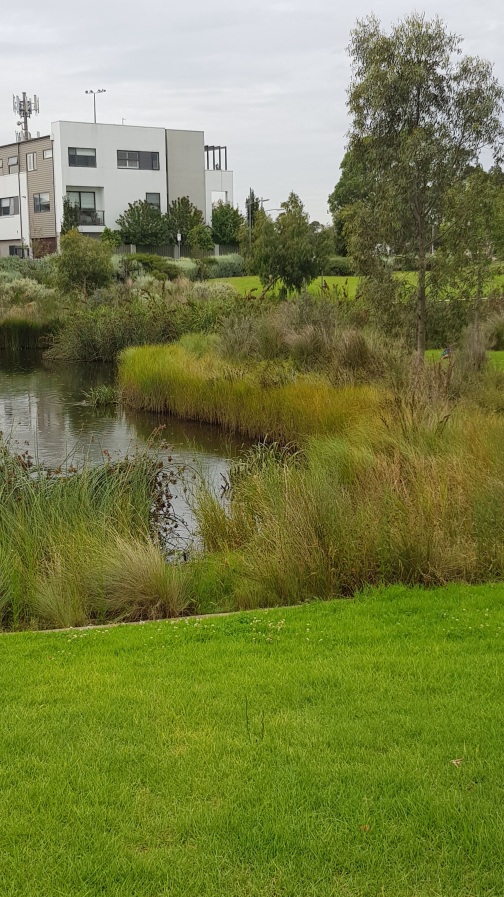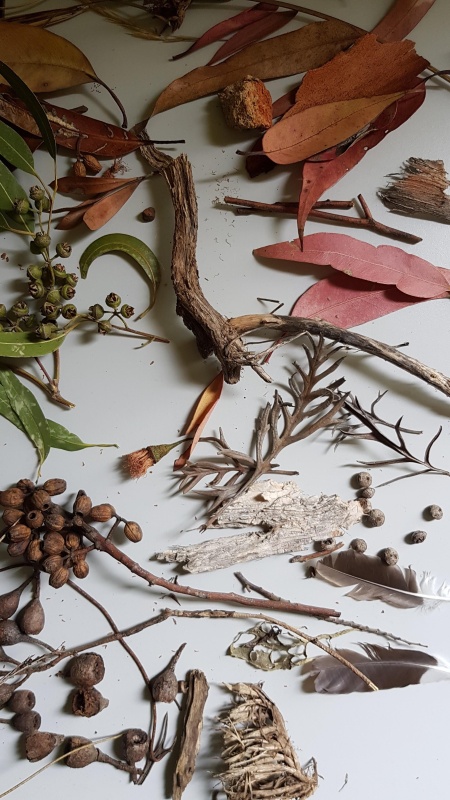Down the end of my street is an oval. When I moved into my house decades ago it was enclosed on three sides by a large, old industrial site. The site was owned by ICI, and aside from the far corner there was little activity. For many years I walked the fenced perimeter peering in at the old buildings, musing about what might have gone there.
The oval was only used by the cricketers and footy teams, and the occasional dog walker. A creek meandered through the site, sometimes buried, sometimes encased in a drain, eventually making its way to the nearby Maribyrnong River.
Of course the site was prime inner suburban land, and after remediation, it was sold to developers. The development wasn’t too bad. The best part though was that the creek was freed from the drain and turned into a wetland. The fences were removed from around the oval, and the space was opened up.
Now I can walk down the end of my street, across the oval and into the wetlands, where there is always something going on.




Now that the fences are down the oval is an integral part of complex and is well used.
I am very fortunate to be able to walk here as my daily exercise. The Fella walks around the oval while I go further around the wetlands and often join up with him on the way home. It is a safe place for kids and scooters and bikes and dogs, there is room for us all.
For me though, it is more than just a place to exercise. I am intrigued by the textures, the reflections, the light.

My fascination never went further than many photos and a thought in the back of my head to translate what I am seeing into art. Then, by wonderful serendipitous luck I enrolled in a course with Tara Axford, whose art I have loved ever since I came across her on Instagram. She takes the different elements of the bush around her home and makes artistic sense of them. The course is designed to help us see past the clutter and messiness of nature to interpret our special places.
I am loving this course, loving it so much that I am taking it slowly, absorbing, learning, allowing my mind to play with the ideas Tara gives.
What’s not to love when the first module encourages me to beachcomb though the wetlands on my walk, picking up treasures as I go. Tara calls these ‘pocket finds’, a term that is perfect! I was so inspired after watching the first video that I went down to the wetlands in the wind and rain to see how different it would be. Of course I came back with many pocket treasures.

Over the last few days I have been creating vignettes with my treasures. Rather compelling and very satisfying.
I wonder how the next modules will help me further interpret the wetlands.







31 replies on “Interpreting the Wetlands”
I am enjoying your selections of “pocket fines” on instagram!
LikeLiked by 1 person
Instagram is the perfect place to display them. The vignettes have an uncluttered look to them that I really like.
LikeLiked by 1 person
those are lovely. My favourite is the green. it appears to have the perfect balance. Thank you for sharing
LikeLiked by 1 person
Thanks Dawn. I only pick up from the ground, so I don’t often have green things. These leaves were lying there, just waiting for me. it turns out that the seedpods were ripe and had millions of tiny seeds. I scattered them back in the wetlands.
LikeLiked by 1 person
Mark-making without brush, pen or pencil! I love it! And the colours are delicate and subtle: I love that the mark IS the colour and the colour is the mark. So much scope for exploration. Some of those arrangements would make wonderful fabric prints!
LikeLiked by 1 person
So true Kate. One of my goals form this course is to develop a visual language of the wetlands, so these unconventional marks become part of that.
I love how your mind turns to fabric!
LikeLike
How do you intend to integrate the water aspect?
And yes, sad but true, I see potential fabric designs everywhere…
LikeLike
as a mixed media artist – incorporating water could be easily achieved by semi-embedding the photograph with the art work. I’ve done that once or twice with something like a magazine cut out. Or one could use a eye glass lens over the top of something that had the feeling of water…the lens would give that kind of “light we see on water during seasons”
sorry to interfere with ideas…my head is full of ideas at the moment!
LikeLike
I’m interested to see how Anne will tackle it; she always comes up with visual solutions that appeal to the fabric artist in me 🙂
LikeLiked by 1 person
I love urban wetlands… these so bring back happy memories of my city wetlands wanderings. More special I think due to their juxtaposition with the
LikeLiked by 1 person
… backdrop of buildings and roads. A lull that heightens the senses. What interesting finds, and that includes the online course. I’ve been enjoying your photos on Insta.
LikeLiked by 1 person
Urban wetlands are one of the good things to have come from urban planning of the last decade or so….remembering what it was like before we built over it, and trying to reclaim some of it. My wetlands are obviously manufactured, but I think, over time, they will develop their own life and habitat, and become a refuge for all sorts of critters.
LikeLike
now that reminds me, not far from here – we have a wetland, again to do with a housing development off side, some creeks and generally not suitable for housing. I used to go there a lot with a friend..but now not so much. It’s well within a “walk for fresh air” and I can always slot into a connecting bus if I overdid on my trip…
maybe you should look into gelli prints…or similar. If you don’t have a commercial plate, apparently you can make your own.
Or preserving them a bit more by painting a glue over them. I use mod/podge because I happen to have that. Gives them a bit of a sheen, but then you can stitch over them as well…https://www.linda-matthews.com/pages-from-my-book-of-days-tips-for-stitching-on-leaves/ – scroll down to how to preserve them. But lots of other tips…
this is tutor, I bought the bundle of workshops from…she has now apparently left the USA where she had resided for 20 years and returned home, Australia!
I like painting over the backs of leaves and laying them down for print, I particularly fond of my grape vine leaves, which are now of course turning to “tones for Autumn and falling to the ground”
but also you might remember I like writing & making marks on mainly fleshy ones with gold pen…
oh sorry got carried away with your “pocket bits” and my ideas that probably are already part of your art arsenal 🙂 love your interpretations…
LikeLiked by 1 person
Funny you mention gelli printing,Catherine, because that is coming up. I have ordered one. Printing will be a whole new experience for me, so any ideas are welcome. I will look at that link. Thanks for your ideas. I am a novice with mixed media, so I welcome your tips and help.
LikeLiked by 1 person
You most definitely have an eye for beauty! I loved the pics, as well as your way of putting your treasures together.
LikeLiked by 1 person
The lovely thing about putting them together is that it was just playing ~ no expectation of a ‘finished product’ ~ and when I was satisfied, or even dissatisfied sometimes, I put the items back onto the table and moved on.
LikeLiked by 1 person
I love looking at water! The colours, movement, sparkle, reflections. When I go to the beach I can never resist picking up shells and pebbles even though I have nothing I need them for! The reds in your top photo are stunning. And I love the idea of savouring the course you are taking and taking time to absorb the learning. More power to you pencil / brush / needle!
LikeLiked by 1 person
That is me too! Water is never the same, is it….ripples, reflections, levels, waves on the beach, different colours in different lights. Perfect!
Maybe these photos will tempt you into playing with your little collected treasures. When you have finished they can go back into the bowl or the jar or wherever they live.
LikeLike
I want to make more ponds in the garden but the ground is so stoney that it is very hard work and once the hole is dug it is very jagged and uneven. Maybe when the next one is done I can do something interesting with my shells and pebbles beside it.
LikeLike
It’s nice to hear about a development that actually opened up a beautiful area rather than destroy it. The vignettes are lovely and make pretty photos – perhaps you could have your favourites made into cards.
LikeLiked by 1 person
Cards are a good idea ~ Thank you!
You are so right about developments have the potential to be ugly blights in our world. I suspect that this land would have been unsuitable for building on, and so they turned it into the wetland.
LikeLike
Oh my goodness those vignettes are amazing! I’ve seen them on your Instagram and now it is wonderful to get the story behind them. What a wonderful place you have to walk and all the inspiration! Sounds like the Tara Axford course is great 🙂
LikeLiked by 1 person
I am loving her course, Tierney. Have a look at her work, as you may get some ideas for your quilts (not that you need more ideas!)
I have downloaded a cameral app and that helps to capture the vignettes too.
LikeLiked by 1 person
I could see art quilt ideas her amazing work 🙂
LikeLiked by 1 person
I’ve enjoyed seeing the vignettes and their variations on your IG feed. Can’t wait to see what else you come up with from the course. And I’m impressed that development didn’t ruin the wetlands. It looks like a great place to wander.
LikeLiked by 1 person
The simplicity of the vignettes is perfect for Instagram. And perfect things to do in isolation. Very meditative and satisfying. I am looking forward to the rest of the course too, which, perversely, is why I am taking it slowly!
LikeLiked by 1 person
Nothing like savoring something good 😊
LikeLike
I love those vignettes, Anne. Little treasures frozen in time. I’m so glad that your art is expanding despite the lockdown. -hugs-
LikeLike
[…] for not getting a lot done is that I am doing an online mixed media course, which I am loving. Read my earlier post if you would like to catch up with […]
LikeLike
[…] my post about how the wetlands were inspiring me? They have continued to be an inspiration, and these artist books are some of the things I have […]
LikeLike
[…] My two works are abstract representations of the wetlands that I have become fascinated with over the last few months. You may remember my post about it. […]
LikeLike